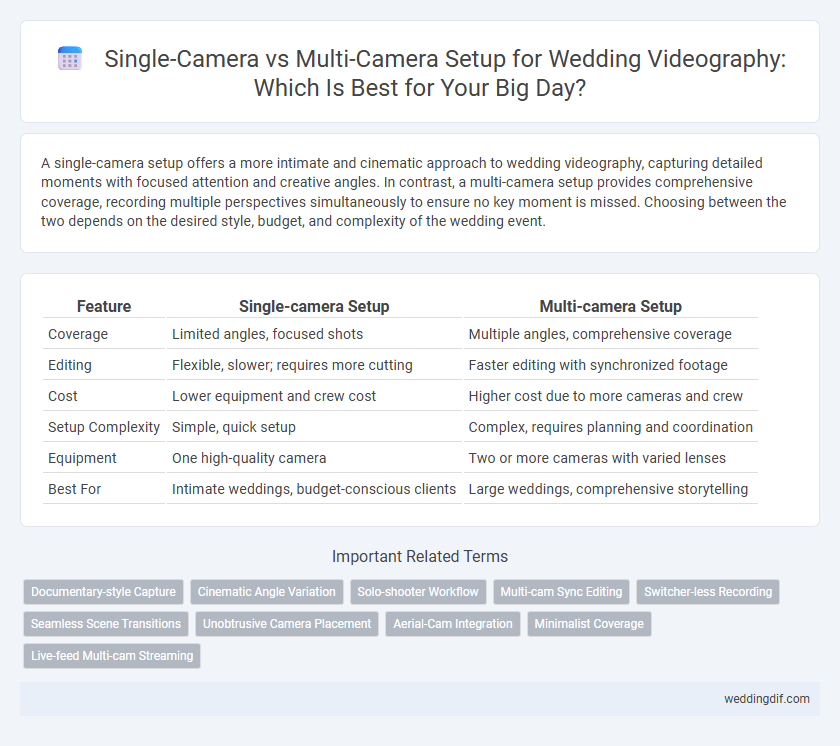A single-camera setup offers a more intimate and cinematic approach to wedding videography, capturing detailed moments with focused attention and creative angles. In contrast, a multi-camera setup provides comprehensive coverage, recording multiple perspectives simultaneously to ensure no key moment is missed. Choosing between the two depends on the desired style, budget, and complexity of the wedding event.
Table of Comparison
| Feature | Single-camera Setup | Multi-camera Setup |
|---|---|---|
| Coverage | Limited angles, focused shots | Multiple angles, comprehensive coverage |
| Editing | Flexible, slower; requires more cutting | Faster editing with synchronized footage |
| Cost | Lower equipment and crew cost | Higher cost due to more cameras and crew |
| Setup Complexity | Simple, quick setup | Complex, requires planning and coordination |
| Equipment | One high-quality camera | Two or more cameras with varied lenses |
| Best For | Intimate weddings, budget-conscious clients | Large weddings, comprehensive storytelling |
Introduction: The Importance of Camera Setups in Wedding Videography
Choosing the right camera setup is crucial in wedding videography to capture every meaningful moment with clarity and emotion. A single-camera setup offers intimate, cinematic shots with flexibility in framing, while a multi-camera setup ensures comprehensive coverage from multiple angles, reducing the risk of missing key events. Understanding these setups helps videographers deliver a polished, storytelling experience that preserves the couple's special day.
What is a Single-Camera Setup?
A single-camera setup in wedding videography involves using one camera to capture all moments, requiring careful planning for varied angles and shots during the event. This approach allows for a more cinematic style, emphasizing creative framing and detailed storytelling through selective editing. It is ideal for intimate weddings where a discreet presence and artistic control are prioritized over extensive coverage.
What is a Multi-Camera Setup?
A multi-camera setup in wedding videography involves using multiple cameras simultaneously to capture different angles, reactions, and moments in real time, ensuring comprehensive coverage. This method enables seamless editing with synchronized footage from various perspectives, capturing both the couple's emotions and the guests' responses. Multi-camera setups are ideal for dynamic events like ceremonies and receptions where multiple focal points and spontaneous moments occur concurrently.
Advantages of a Single-Camera Setup
A single-camera setup in wedding videography offers enhanced creative control, allowing the videographer to carefully frame each shot and capture detailed, cinematic footage with precision. This approach ensures consistent lighting and color grading, resulting in a polished and cohesive final video. The portability of a single camera also enables unobtrusive movement, capturing authentic moments without disrupting the event's natural flow.
Advantages of a Multi-Camera Setup
A multi-camera setup for wedding videography captures diverse angles simultaneously, ensuring no important moment is missed and providing dynamic coverage that enhances storytelling. This approach allows editors to seamlessly switch perspectives during post-production, resulting in a more engaging and professional video. Multiple cameras also reduce the risk of technical issues disrupting the entire shoot, offering greater reliability and comprehensive event documentation.
Limitations of Single-Camera Wedding Coverage
Single-camera wedding setups often limit coverage by capturing only one angle at a time, potentially missing key moments or reactions during fast-paced events. This restriction increases post-production time due to the need for multiple retakes or creative editing to maintain continuity. The lack of simultaneous perspectives can affect the emotional storytelling and dynamic representation of the ceremony and reception.
Challenges of Multi-Camera Wedding Videography
Multi-camera wedding videography presents challenges such as synchronizing footage from various angles, requiring advanced editing software and skills to ensure seamless transitions. Coordinating camera operators to avoid capturing each other and managing limited space can complicate shot composition. Additionally, increased equipment demands raise logistical complexities and costs compared to single-camera setups.
Visual Storytelling: Single vs Multi-Camera Approaches
A single-camera setup in wedding videography allows for a more cinematic and intimate visual storytelling approach, capturing details and emotions with precise framing and creative angles. Multi-camera setups provide a comprehensive coverage of the event, capturing multiple perspectives simultaneously to ensure no moment is missed, essential for dynamic scenes like vows or the first dance. Combining shots from multiple cameras enhances the editing process, offering a rich narrative flow, while single-camera shoots emphasize artistic control and mood.
Budget Considerations: Cost Differences Explained
A single-camera setup for weddings is typically more budget-friendly, requiring fewer crew members and less equipment, which reduces overall production costs. Multi-camera setups involve multiple operators and additional cameras, increasing expenses but providing comprehensive coverage from diverse angles. Opting between these setups depends on balancing cost efficiency against the desired depth of event coverage and post-production flexibility.
Choosing the Right Setup for Your Wedding Video
A single-camera setup offers intimate, cinematic shots perfect for capturing emotional moments, while a multi-camera setup provides comprehensive coverage from multiple angles, ensuring no detail is missed. Selecting the right setup depends on your wedding size, venue layout, and desired video style, with single-camera ideal for smaller, more personal ceremonies and multi-camera suited for large, dynamic events. Evaluating budget constraints and post-production timelines also helps determine whether versatility or simplicity best fits your wedding videography needs.
Single-camera Setup vs Multi-camera Setup for weddings. Infographic

 weddingdif.com
weddingdif.com